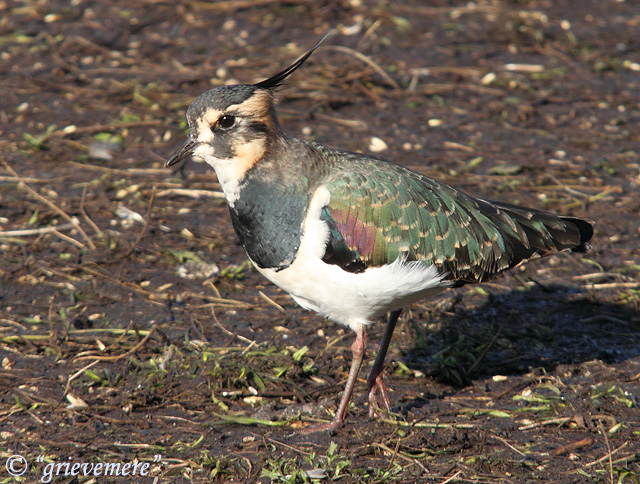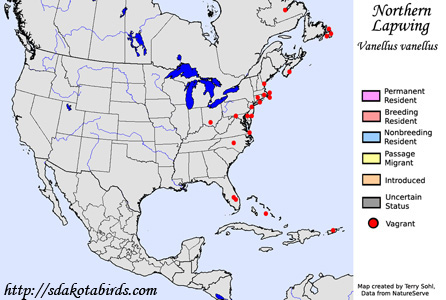Northern Lapwing
Vanellus vanellus
| Length: 12.5 inches | Wingspan: 32 inches | Seasonality: Non-resident in South Dakota |
| ID Keys: Obvious large crest, black breast, greenish back, white underparts, white and black facial pattern in breeding plumage (cream colored face on non-breeders) | ||
 The
Northern Lapwing is a species common in Europe and Asia, but vagrants have
been found a number of times along the east coast of the United States and
Canada. Winter storms in the Atlantic have occasionally been
associated with small influxes of Northern Lapwings in North America.
In the fall of 2012, the large and destructive Hurricane Sandy was followed
by many sightings of Northern Lapwings in the northeastern United States and
southeastern Canada.
The
Northern Lapwing is a species common in Europe and Asia, but vagrants have
been found a number of times along the east coast of the United States and
Canada. Winter storms in the Atlantic have occasionally been
associated with small influxes of Northern Lapwings in North America.
In the fall of 2012, the large and destructive Hurricane Sandy was followed
by many sightings of Northern Lapwings in the northeastern United States and
southeastern Canada.
Habitat: Northern Lapwings are a "shorebird" that is more often found in open agricultural fields, short grasslands, or mudflats.
Diet: Feeds on insects, worms, spiders, and other small invertebrates.
Behavior: Forages by walking along the ground in search of invertebrates. They are usually very gregarious during migration and in winter, and can be found in large foraging flocks. They will feed both during the day and night, often feeding at night for worms and other invertebrates that are more easily obtained at that time.
Nesting: The nest is a simple scrape on the ground, lined with various bits of vegetative material. The female lays between 3 and 5 eggs, and both parents help to incubate them. After the eggs hatch, both parents help to raise the young.
Song: Calls include a series of high thin whistles, or a crisp, short "pee-wit". The species is sometimes locally known as a Peewit.
Migration: While Northern Lapwings are semi-permanent residents in parts of their normal Eurasian range, most birds are migratory, breeding in Europe and northern Asia, with wintering locations including southern Europe, northern Africa, the Middle East, and southern and southeast Asia.
Interactive eBird Map: Click here to access an interactive eBird map of Northern Lapwing sightings
Similar Species: Distinctive if seen well.
Conservation Status: While populations may be decreasing, Northern Lapwings are still found over a large geographic region and are common in some parts of their range. The IUCN lists the Northern Lapwing as a species of "Least Concern".
Further Information: 1) WhatBird - Northern Lapwing
2) BirdLife International - Northern Lapwing
3) Royal Society for the Protection of Birds - Northern Lapwing
Photo Information: Photo taken by "grievemere" - November 9th, 2009 - Lancashire, England, Great Britain - Photo licensed under Creative Commons Attribution NonCommercial ShareAlike 2.0 Generic License.
| Click below for a higher-resolution map |
 |
| South Dakota Status: Non-resident in South Dakota |
Additional Northern Lapwing Photos (coming soon!!)
